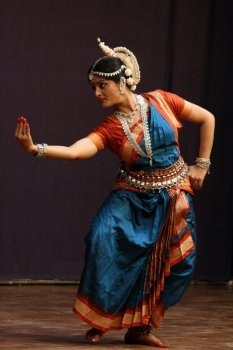
|   |

|   |
Anu Narayan’s Odissi performance - Pandithar Sivakumar Perumal, Pune e-mail: spandithar@yahoo.com November 15, 2011  A bright point on the wet rainy evening of Oct 19 in Pune was the
Symbiosis Auditorium, where Anu Narayan’s graceful Odissi recital for
the Horizon series of the ICCR and Symbiosis enchanted the rasikas. She
is a disciple of Debi Basu. A bright point on the wet rainy evening of Oct 19 in Pune was the
Symbiosis Auditorium, where Anu Narayan’s graceful Odissi recital for
the Horizon series of the ICCR and Symbiosis enchanted the rasikas. She
is a disciple of Debi Basu. Anu had chosen the theme ‘Amatra’ challenging the finite path of the human emotions and overcoming it towards infinity. As the dancer described this theme, she elaborated on the various emotions like bhakti, shringara, vatsalya, viraha amongst many others. Anu commenced with offering prayers through managalacharan, the invocatory item. The bhumi pranaam was followed by a shloka on Lord Rama. The abhinaya item in Oriya “Braja ku chora” was about the mother, how she epitomizes love for her beloved child, and is a synonym of selflessness. Playing with the toddler, holding his hand, Anu’s ability to portray this love was a visual delight, and at no moment did one feel the absence of the child on the stage, the gentleness in the dance and her expressions synchronized so well. Set to rag Behag, Pallavi or the pure dance item was performed with scintillating foot work. Her ability to use the entire stage and striking statuesque poses with great control showed her expertise. And then came the moment of witnessing something for the first time, Odissi being performed to a Tamil composition, “Netru andhi nerathile,” an experiment at adapting a Tamil song to the grace and technique of Odissi. Anu has definitely put in a lot of effort in this piece. The nayika is deeply pained at the sight of seeing the nayaka in the company of another woman; his attraction to the other woman has grieved the nayika. As the end of the item, the nayika reminds the nayaka of the promises that he had made to her, and asks him to come back to her and remove all her pains. The artiste brought the characters to life and the associated joy and grief. Ashtapadi is an essential item in an Odissi dance recital. In the famous Jayadeva ashtapadi “Priye charu sheele,” the lord seeing the mental agony of Radha, assures her that they are inseparable and that she is the invaluable jewel of his existence. Krishna entreats Radha to abandon her anger and return to him. In this item, the dancer brought forth the pain of the lord for Radha, through her expressive abhinaya. The power packed concluding item ‘Durga Stuti’ was dedicated to goddess Durga. The entry is sublime but as the item progresses, the pace of the music and the dance gain tempo; the anger spreads on the face of the goddess as Mahishasuramardini when she holds the weapons that put an end to the evils. Each facet of the goddess was evocatively depicted. The recital ended with a mangala shloka merging into the eternal silence of Om, where all aspects of creation begin and end. There were many controlled stances in this that impressed the rasikas. |